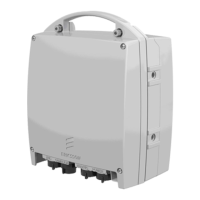MINI-LINK BAS 9-20
Technical Description EN/LZB 111 0542 P2B
9.7.10.2 Case B
This case it the most critical one, as after the upgrade command, see
Paragragh 9.7.8, no remote terminal is able to re-establish the
connection. This would imply to send installation personnel to each
remote site. The immediate consequence would be very long traffic
interruption times and high costs.
In order to avoid these consequences, an autonomous capacity to
rollback the SW load module is included in the AT-DP. The AT must
be able to distinguish between a radio link outage due to external
propagation conditions or to RN failures from sw related problems.
Therefore, the main event needed to start the procedure for an
automatic rollback is that the last operation executed before the
rollback was a SW swap. Moreover, in order to avoid oscillations
between the two sw load modules, the automatic rollback must be
enable only after a new load module download and disable
immediately after its execution. The AT automatic rollback procedure
is depicted in Figure 9-5.
9.7.10.3 Case C
In theory this situation should never happen, as the same SW problem,
if any, is expected to be experienced by all the ATs concurrently. In
practice, however, a deployed network could contain ATs installed in
different times with different hardware revisions. Even though
backward compatibility within the R1 system is guaranteed, however
the effect of a SW problem could not always be the same.
It’s not so easy to define a common strategy for all these situations.
For example, if after a SW upgrade procedure 95% of the ATs have
been reconnected, it will be very likely that the remaining 5% have
made a SW rollback. It’s up to the operator’s strategy to decide if
rollback the complete network including the 95% ATs already
reconnected or to send maintenance personnel to the 5% remote sites
to solve the problem.

